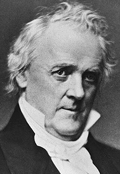 |
James Buchanan
b. 23 Apr 1791, Cove Gap, Franklin County, Pennsylvania
d. 1 Jun 1868, "Wheatland" (near Lancaster), Pennsylvania |
| Title: |
President of the United States |
| Term: |
4 Mar 1857 - 4 Mar 1861 |
| Chronology: |
11 Feb 1857,
the election to the office of the President of the United States is declared upon the ascertainment and counting of the electoral vote (cast 3 Dec 1856),
joint session of the Senate and the House of Representatives, House Chamber, U.S. Capitol, Washington, D.C. [1] |
|
4 Mar 1857,
commencement of term |
|
4 Mar 1857,
took the oath of office as the President of the United States, inaugural ceremony as part of the special session of the Senate, East Portico, U.S. Capitol, Washington, D.C. [2] |
|
4 Mar 1861,
expiration of term |
| Biography: |
| Moved to Mercersburg, Pennsylvania, with his parents in 1799; was privately tutored and then attended the village academy; graduated from Dickinson College, Carlisle, Pennsylvania, in 1809; moved to Lancaster, Pennsylvania, the same year; studied law; admitted to the bar in 1812 and practiced in Lancaster; was one of the first volunteers in the War of 1812 and served in the defense of Baltimore; member, State house of representatives 1814-1815; elected to the 17th and to the four succeeding Congresses (4 Mar 1821 - 4 Mar 1831); chairman, Committee on the Judiciary (21st Congress); was not a candidate for renomination in 1830; one of the managers appointed by the House of Representatives in 1830 to conduct the impeachment proceedings against James H. Peck, judge of the US District Court for the District of Missouri; Minister to Russia 1832-1834; elected as a Democrat to the United States Senate to fill a vacancy; reelected in 1837 and 1843 and served from 6 Dec 1834, until he resigned on 5 Mar 1845, to accept a Cabinet portfolio; chairman, Committee on Foreign Relations (24th through 26th Congresses); Secretary of State (10 Mar 1845 - 7 Mar 1849) in the Cabinet of President James Polk; Minister to Great Britain 1853-1856; elected as a Democrat as President of the United States in 1856; prevention of Northern antislavery agitation and the enforcement of the Fugitive Slave Act (1850); embroiled in the explosive Kansas struggle (1854-1859); economic panic of 1857; raid on the arsenal at Harpers Ferry, Virginia (1859), by the Abolitionist John Brown; refused to surrender any of the federal forts and ordered reinforcements (1861) sent to Fort Sumter at Charleston, South Carolina; retired to his home "Wheatland," near Lancaster, Pennsylvania, where he died. |
| Biographical sources: Biographical Directory of the United States Congress (2005). |
| Elections: |
| Candidate |
Electoral vote (3 Dec 1856) |
| James Buchanan |
174 |
| John Charles Frémont |
114 |
| Millard Fillmore |
8 |
| total number of electors appointed |
296 |
| number of votes for a majority |
149 |
|
| Source of electoral results: Senate Journal, 34th Congress, 3rd Session, 189-191; Congressional Globe, 34th Congress, 3rd Session, 652.
|
| |
| [1] |
Senate Journal, 34th Congress, 3rd Session, 188-191; Congressional Globe, 34th Congress, 3rd Session, 644-660. |
| [2] |
Senate Journal, 34th Congress, 3rd Session, 373-383; Congressional Globe, 34th Congress, 3rd Session, Appendix, 371-372. |
|
Image: daguerreotype by Mathew Brady. |

